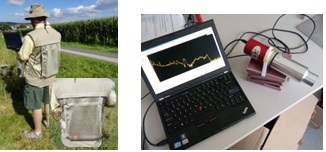4.3.2.3 Improved energy resolution scintillation detectors
LaBr3 and CeBr3 detectors have emerged during the last years as an option for in situ gamma spectrometry with an energy resolution between that of common scintillators and the insuperable of HPGe detectors.
The LaBr3 detector provides improved energy resolution compared to aforementioned scintillators (NaI, Cs(I), BGO), fast scintillation emission, excellent stability with temperature and linearity characteristics. Typical energy resolution at 662 keV is ∼2-3 % (depending on the crystal size). CeBr3 detectors are preferable to LaBr3:Ce for low-count-rate experiments because of their low intrinsic activity as well as the increased detection sensitivity. Co-doping techniques are effective to enhance the CeBr3 energy resolution to at least 3% for 662 keV.

LaBr3 and CeBr3 detection systems provide higher efficiency per unit of volume, allowing manufacturing smaller dimensions crystals, but can also be constructed with dimensions up to 3x4 inches. Although LaBr3 and CeBr3 detectors are more expensive they are already in use for in-situ environmental radioactivity applications and dose rate measurements.